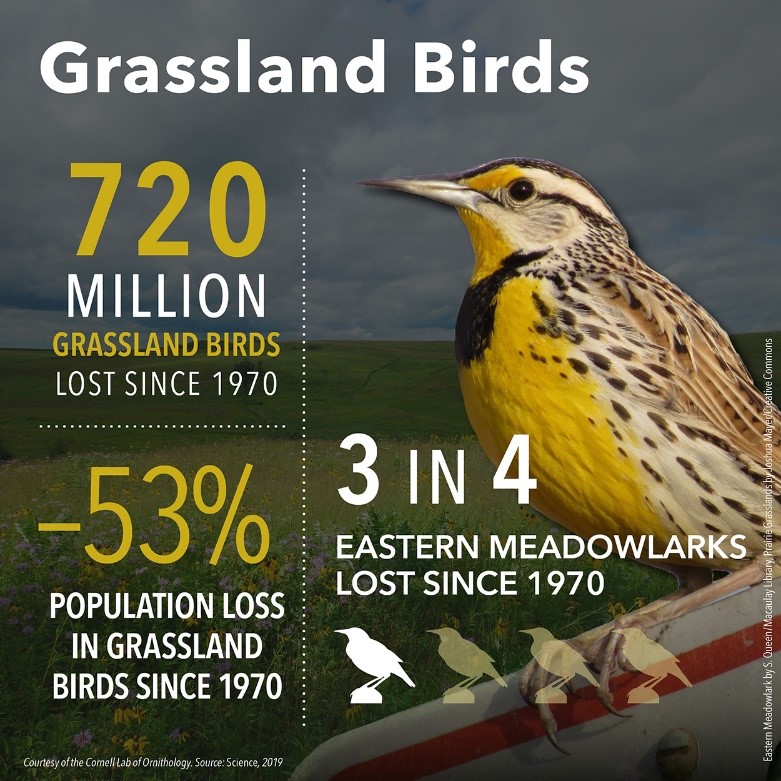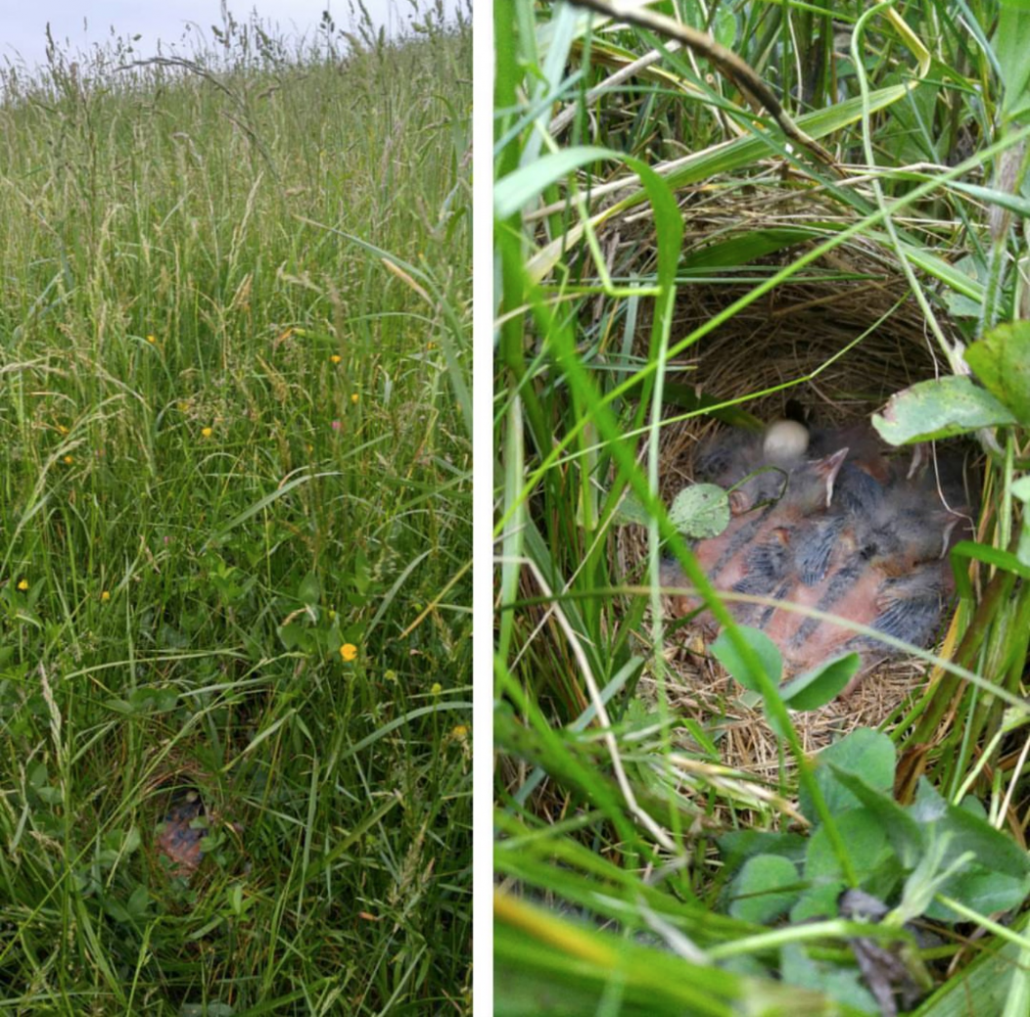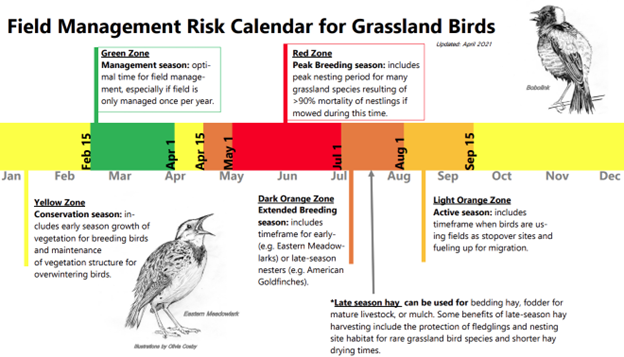Timing field management in and around solar fields to optimize conservation opportunities for declining grassland birds
Dr. Amy Johnson, Conservation Biologist and Program Director, Virginia Working Landscapes, Smithsonian’s National Zoo and Conservation Biology Institute
Biodiversity is declining globally at an alarming rate. While multiple ecosystems are at risk, our planet’s terrestrial grasslands are suffering precipitous losses. In North America, less than 1% of native grasslands remain.
As a result, species that rely on grassland habitat are in trouble. A recent study published in Science revealed that grassland birds are declining more than any other group of birds (Rosenberg et al, 2019; Figure 1). These are species that rely on contiguous open spaces, mostly free from trees, for nesting, foraging, and survival.

In the eastern United States, the majority of grassland habitat is under private ownership. Much of these grasslands are working lands, with hay production and grazing being the most common land uses. A growing number of these working lands are also contributing to an expanding network of solar fields, often integrating solar infrastructure into actively farmed or post-agricultural fields. Simultaneously, these eastern grasslands are host to some of North America’s most vulnerable grassland birds, including Eastern meadowlarks, Grasshopper sparrows, and Bobolinks, which have experienced population declines of 75%, 68%, and 65%, respectively, since the 1970s. As such, it is critical that we prioritize research to better understand how these populations are impacted by grassland management. More importantly, in order to be successful in developing effective conservation strategies for these species on working lands, it’s necessary to facilitate a model that considers the needs of both wildlife and people.
In Virginia, a team of conservation scientists is collaborating with community partners and a network of private landowners and producers to conduct research on grassland birds on working lands. Virginia Working Landscapes (VWL) is a program of Smithsonian’s National Zoo and Conservation Biology Institute, and its mission is to promote the conservation of native biodiversity and sustainable land management through scientific research, education, and community engagement. Since 2010, VWL has recruited over 180 properties (totaling over 80,000 acres) that have provided researchers access for the purpose of conducting ecological research on how land management impacts biodiversity. Grasslands included in this research include fallow post-agricultural fields, solar fields, active hayfields, and livestock pastures, restored native grasslands and wildflower meadows. From this, VWL researchers have been able to assess how bird communities respond to different land management practices, including the timing of management, and have been able to apply these findings to best management practices that support grassland bird populations.
Solar is quickly emerging as one of the Virginia’s leading sources of renewable energy, with more arrays being constructed every year. With the majority of these installations occurring in and around agricultural fields, we often think about the impacts that solar may have on grassland bird communities. While there’s been minimal research on this topic (Horváth et al., 2009; DeVault et al., 2014), there are several organizations actively looking into it (see SUNY New Paltz, Virginia Pollinator Smart, Grassland Bird Trust).
One aspect of solar management that hasn’t been discussed in great detail in scientific literature is vegetation management in solar fields specific to grass and shrubland birds. With much of VWL’s research focusing on field management (not to mention the fact that it’s currently peak mowing season here in Virginia!), I wanted to use this as an opportunity to share some insights on how landowners and managers can optimize grassland management for bird communities within solar fields and beyond.
In eastern grasslands specifically, we have identified two distinct communities of birds nesting in grasslands. One we identify as grassland obligates, which include those birds that nest directly on the ground in open grasslands, including species like Eastern meadowlarks, Bobolinks, and Grasshopper sparrows. Others we refer to more commonly as shrubland birds, which often build their nests off the ground in low-lying vegetation amongst the branches of woody shrubs or weaved through the stems of sturdy wildflowers. Examples of these species include Indigo buntings, Field sparrows, and Prairie warblers. Depending on the composition and structure of the vegetation growing in and around your solar fields, it’s possible that both groups of these birds are nesting amongst solar arrays and surrounding habitat. For example, if a solar array is installed in conjunction with a pollinator wildflower mix, it may be likely that shrubland species are nesting nearby. VWL research is demonstrating that wildflower meadows support significantly higher densities of shrubland birds than fallow or agricultural fields. In contrast, arrays surrounded by fescue pasture and/or hay grasses it may be more likely to have higher densities of grassland obligates present, potentially nesting directly on the ground. Therefore, the composition of the vegetation surrounding your solar array could help determine the optimal time for field management based on the nesting phenology of the species most associated with that habitat.
In Virginia, Eastern meadowlarks start nesting as early as April 15, with peak nesting activity occurring in mid- to late May (Figure 2). Bobolinks follow shortly behind with peak nesting activity occurring in early June. Unfortunately, this is also the most popular time for field management, especially if fields are managed for hay and/or grazing, and this can have drastic negative impacts on grassland bird survival. For example, a New York study showed that hay harvests during peak nesting season resulted in 94% mortality of eggs and nestlings of grassland birds (Bollinger et al.,1990). Other species more commonly associated with wildflower meadows, like Blue grosbeaks and Field sparrows will nest into late June/early July. As such, it is important to consider the species using your fields when scheduling field management activities. For this reason, we created a “Field Management Risk Calendar” (Figure 3) to help guide managers on the optimal times to manage fields for the benefit of birds.


As the calendar illustrates, delaying field management from mid-June to July 1 can make a significant difference for the survival of nestling grassland birds. Delaying to July 15 or even August 1 is even more impactful, especially for those late-nesting shrubland species. We also recognize, however, that delaying management isn’t always feasible. As such, we are currently collaborating with farmers in Virginia to identify optimal windows for early field management that will still offer opportunities for birds to fledge their young. For example, is it possible to mow early in the season, prior to peak grassland bird nesting, and still provide the necessary vegetation structure for nesting birds in late May and into June? Stay tuned to www.VAWorkingLandscapes.org to hear more as we continue collecting data on this front. In the meantime, I encourage you to refer to our Field Management Guidelines for Grassland Birds to learn more about the species that use our eastern grasslands and how we can adapt our management regimes to optimize their conservation.
References
Bollinger, E.K., P.B. Bollinger, and T.A. Gavin, . 1990. Effects of Hay-Cropping on Eastern Populations of the Bobolink. Wildlife Society Bulletin, 18(2): 142-150.
DeVault, T.L., T.W. Seamans,, J.A. Schmidt., J.L. Belant,, B.F. Blackwell, N. Mooers, L.A. Tyson, and L. Van Pelt. 2014. Bird use of solar photovoltaic installations at US airports: Implications for aviation safety. Landscape and Urban Planning,122: 122-128.
Horvath, G., G. Kriska, P. MalikB. . and Robertson. 2009. Polarized Light Pollution: A New Kind of Ecological Photopollution. Frontiers in Ecology and the Environment, 7: 317-325.
Rosenberg, K.V., A.M. Dokter, P.J. Blancher, J.R. Sauer,, A.C. Smith, P.A. Smith, J.C. Stanton, A. Panjabi, L. Helft, M. Parr, and P. Marra. 2019. Decline of the North American avifauna. Science, 366: 120-124.
